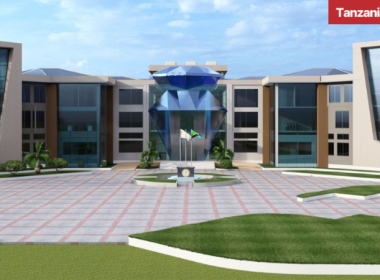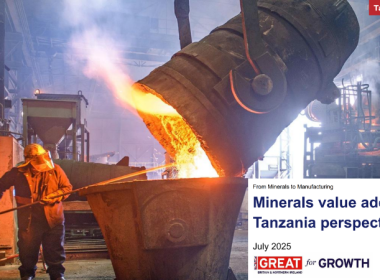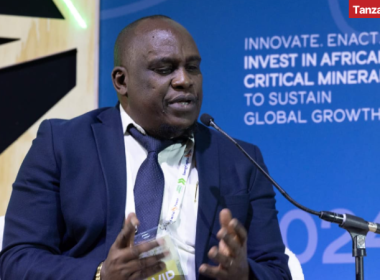Minerals
 Minerals in Tanzania
Minerals in Tanzania
The minerals found in Tanzania include metallic minerals, industrial minerals, and energy minerals.
Minerals export accounted for USD 2.3 billion of the total value of Tanzania’s export in 2019 (i.e. 45%).
Tanzania Metallic Minerals
The metallic minerals found in Tanzania include gold, iron, silver, copper, platinum, nickel, and tin.
Tanzania Gold
Gold reserves in Tanzania are estimated at about 45 million ounces.
Gold exploration has been centered mostly on the greenstone belts around Lake Victoria, where several large deposits have already been discovered and are being developed.
Gold production in Tanzania stood at 39 tonnes in 2018, compared to 43 tonnes in 2017 (-10%) and 40 tonnes in 2014 (-3%).
Tanzania’s gold production increased by more than 700% over the past 25 years, from 5 to 40-50 tonnes per year, while South Africa’s production of gold decreased from over 500 tonnes in 1990 to 117 tonnes in 2018.
Gold exports account for more than 90% of Tanzania’s total mineral exports with USD 1.5 billion in 2018, compared to USD 943 million in 2014, an increase of 59%.
Tanzania Iron Ore
Iron reserves in Tanzania are located mainly in Liganga, Uluguru Mountains, Mbabala near Lake Tanganyika, Karema, Manyoro Gondite, and Itewe.
The Liganga iron ore mine holds the biggest iron resources in Tanzania with proven reserves of 126 million tonnes.
Tanzania China International Mineral Resources Ltd (TCIMRL) has invested USD 1.8 billion at Liganga for the establishment of an iron ore mine and iron and steel complex to produce 1.0 million tonnes per year of iron and steel products, vanadium pentoxide, and titanium dioxide. The project is expected to be completed by the end of 2020.
Tanzania Nickel
Mineral exploration of nickel in Tanzania takes place at the Kabanga Nickel Sulfide Deposit and the Kapalagulu intrusion.
Kabanga deposit is acknowledged to be one of the largest and richest undeveloped nickel sulfide deposits known at present, of unmatched scale and grade.
The Kapalagulu intrusion present nickel mineralization of both laterite (nickel associated with cobalt) and sulfide (nickel associated with copper and platinum-group elements)-the two main types of nickel deposit currently exploited at a global scale.
Tanzania Industrial Minerals
Industrial minerals found in Tanzania include gemstones, soda ash, gypsum, salt, phosphate, gravel, sand, dimension stones, and lately graphite.
Tanzania Gemstones
Tanzania produces a variety of gemstones including diamonds, tanzanite, amethyst, aquamarine, garnet, ruby, sapphire, tanzanite and tourmaline.
Diamonds in Tanzania are found mainly in the Williamson diamond mine, which is located south of the town Mwanza, while tanzanite is found at only one location in the world, the Mererani Hills of Manyara Region in Northern Tanzania.
Tanzania Diamonds
Petra Diamonds, through its subsidiary Williamson Diamonds Limited, holds 75% of the ownership rights over the mine, while the remaining 25% is owned by the Government of Tanzania.
According to Petra Diamonds, the Williamson mine contains large diamond resources of approximately 38.1 million carats.
In 2019, the company achieved the highest level of production at the mine in over 40 years, with 399,615 carats produced (2020: 298,130 carats).
Tanzanite
Tanzanite is mined from a single source in an area that is 2km wide and 4 km long and divided into 4 blocks (A, B, C, and D) near Mount Kilimanjaro.
Block C is the largest area operated by TanzaniteOne Mining. Medium-scale mining is undertaken by Kilimanjaro Mining in Block A and Tanzanite Africa in Block D-extension.
Blocks B and D are mined largely by thousands of artisanal miners who use non-mechanized methods.
The production of tanzanite is volatile standing at 21.5 tonnes in 2017, compared to 30.9 tonnes in 2016 and 6.4 tonnes in 2015.
Tanzania Graphite
Tanzania’s largest graphite deposits are located in the central and east southern regions of the country.
Bunyu graphite project, located in the Mtwara Region, is the largest graphite mineral resource in Tanzania. The project is owned by Volt Resources, an Australian graphite exploration company.
The project is planned to be developed in two phases. Volt submitted the mining license application for stages one and two of the development to the Ministry of Minerals in the first quarter of 2018.
Stage one development will enable Volt to establish infrastructure and market position for the development of stage two. The annual throughput of stage one will be 400,000 tonnes of ore and 23,700 tonnes per year of graphite over a seven-year mine life.
Tanzania Energy Minerals
Energy Minerals found in Tanzania include coal and uranium.
Tanzania Coal
Coal reserves in Tanzania are estimated at 1.9 billion tonnes, 25% of which are proven.
Coalfields with the highest potential are Ketawaka-Mchuchuma in the Ruhuhu Basin, Ngaka fields in the South-West of Tanzania, and Songwe Kiwira fields.
Coal is currently exploited on small scale at Kiwira Coal Mine in Mbeya Region and Tancoal Energy Limited Mine at Ngaka in Ruvuma Region.
Coal production in Tanzania increased by 155% over the past five years, from 246 tonnes in 2014 to 628 tonnes in 2018.
Tanzania Uranium
Tanzania has found huge deposits of uranium mainly in Namtumbo (Mkuju), Bahi, Galapo, Minjingu, Mbulu, Simanjiro, Lake Natron, Manyoni, Songea, Tunduru, Madaba, and Nachingwea.
One of the major uranium development projects is the Mkuju River Project with estimated reserves of 182.1 million tonnes.
The project’s operator is Mantra Tanzania, a subsidiary of Russia’s Uranium One Group. In 2017 Mantra suspended further development of the project due to low uranium prices.
Last Updated: 9th March 2021












